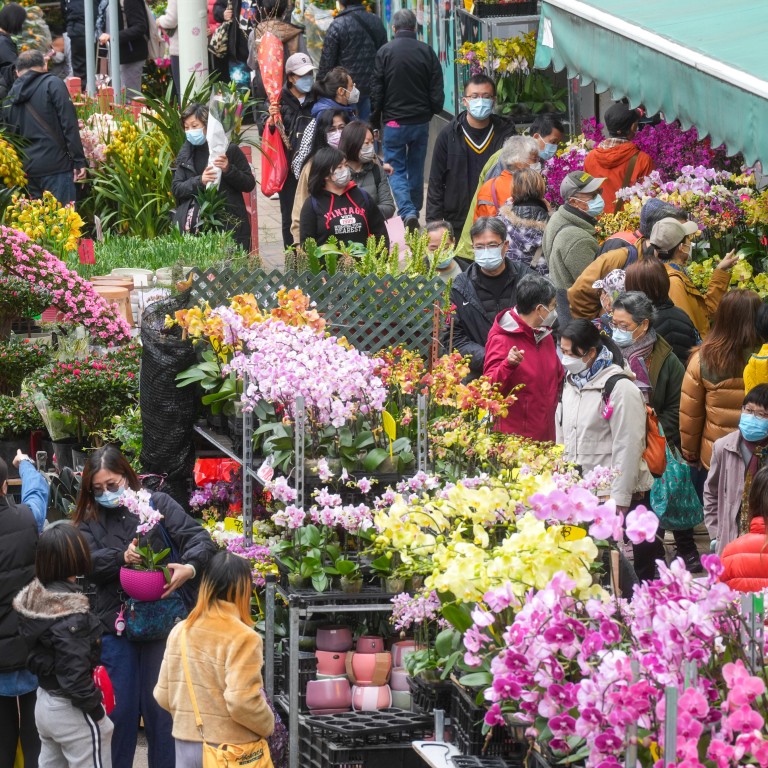
Hong Kong flower market redevelopment plans could take bloom off unique atmosphere, critics say, but URA insists proposals guarantee its future
- Urban Renewal Authority insists redevelopment plan will not ‘destroy’ Mong Kok flower market’s charm, but improve business for traders and the city economy
- But former chief executive CY Leung says better understanding of traders’ needs needed, rather than ‘relying solely on financial incentives’
Wai Chi-sing, the managing director of the authority, emphasised on Sunday that plans to revamp the area to bring it up to date was its best chance to guarantee sustainable development.
But a florists’ representative said he and many fellow vendors he knew were not consulted. He also questioned the need for a large-scale redevelopment.
Wai said in a blog post that the proposals to revitalise the Mong Kok market would benefit traders because private developers did not as a rule offer better compensation or relocation packages than the URA and that consultation had been carried out.
“Just imagine if the buildings are not redeveloped by the URA in an orderly manner, but get picked up by private developers for their separate development projects, how would it affect the integrity of the market?” Wai asked.
“Not only would shop tenants not receive compensation assistance from the URA, let alone the option of transitional or relocation operations under such circumstances, but how could the atmosphere and characteristics of the flower market be preserved and continued?”
Wai launched his defence of the partial makeover plan for the market after a former leader of the city, Leung Chun-ying, also an ex-URA board member, and others warned that more careful planning was needed to preserve the site.

The proposals include the creation of a canal to link the area’s public leisure areas, the redevelopment of 31 buildings more than 60 years old, as well as the upgrading shops in the market and neighbouring areas such as Sai Yee Street and Fa Yuen Street.
The redevelopment plan, unveiled earlier this month, sparked concerns by flower sellers and residents in the area, who said they were worried that proposals could take the bloom off the unique characteristics and authenticity of the market.
Leung appealed for more careful planning and a stronger understanding of the neighbourhood’s needs, “rather than relying solely on financial incentives”.
He added the authority’s attempts to improve the Bird Garden in Mong Kok, a haven for caged songbirds and their owners, and redevelopment of Wing On Street in Central, formerly known as “Cloth Lane” because of its array of fabric sellers, had ended up being “lifeless”.
But Wai said it was unfair to criticise plans to improve the area of the flower market and guarantee the livelihoods of traders.
“Remarks that equate ‘redevelopment’ with the destruction or elimination of local characteristics in a generalised way, while ignoring problems faced by flower market vendors and the need for sustainable development, lack a forward-looking vision,” he added.
Mong Kok flower market set for partial makeover in Hong Kong renewal project
“[These comments] are not beneficial to Hong Kong’s long-term development.”
Wai said a survey found more than 90 per cent of flower sellers who responded felt there was a need for extra parking spaces and improved pedestrian access to boost foot traffic and attract more visitors.
More than half of those polled said present policies did not provide opportunities for business expansion and that there had been a decline in business because of an increased trend towards buying flowers online.
More than half of shop operators and visitors suggested the design of surrounding areas should be improved to include “flower-viewing hotspots” and diversification of activity to enhance the market’s appeal.
Wai said plans such as the relocation of some stores to create more space, a proposed multipurpose building and underground public car park with about 220 spaces, extra loading and unloading docks and the construction of an “urban waterway” would help tackle people’s concerns.
Mong Kok flower market makeover must keep character
Lai Wing-chun, the head of the Hong Kong Wholesale Florist Association, said he was never approached by authorities and he did not know of any fellow flower sellers who had spoken to them.
“I am not sure where they got those numbers from, but I spoke to vendors and they did not agree the redevelopment was a good idea,” Lai, whose organisation represents 122 florists in the market, added.
Lai added the announcement came as a shock and there were worries that once construction began for the dozens of shops earmarked for redevelopment, business would be badly affected.
“There will be dust everywhere,” Lai said. “How can we get customers? And once they are done, will all the shops go back to the industry?”
Lai said he was concerned that some space would end up as restaurants or retailers of different kinds, increasing competition and spoiling the character of the area as a market for plants and flowers.
He also questioned whether the HK$2.5 billion set aside by the URA for acquisitions was enough because there were owners of 33 shops involved.
